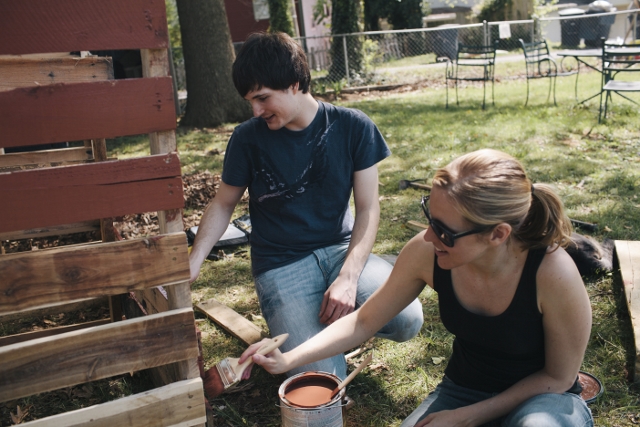
Doctors who make house calls are rare, especially in urban settings like Roanoke. Nonetheless, students from the Virginia Tech Carilion School of Medicine are taking to the streets throughout the local community.
And they’re treating much more than just the residents’ health.
These future doctors are getting involved in a variety of ways, from helping women who are attempting to shake their addictions to assisting with community gardens. The students aren’t the only ones doing the teaching, however, because these educational endeavors are a two-way street.
“We’re looking to educate well-rounded physicians, both inside the hospital and out,” said Dr. David Trinkle, associate dean of community and culture at the school of medicine. “Through these service learning projects, we hope the students gain a better understanding and respect for the people in the community around them, their daily trials, and where the students’ own passions can make a difference. By the end of their projects, they will have added value not just to their surroundings, but to themselves.”
That’s the idea behind the school of medicine’s inclusion of service learning into its curriculum. Earlier this year, teams of students spent several hours each week working with their chosen service organization.
The projects offered the opportunity to interact with the public, work as a team, and work with populations with whom many have little experience. They also served as an avenue for the medical students to become acquainted with other health care professionals.
As part of the program’s emphasis on interprofessionalism, each service project team is composed of a mix of students from the school of medicine and Jefferson College of Health Sciences, which trains nurses, physician assistants, and other health professionals. The goal is to have the different professions learn to work together and respect one another’s roles in health care so they can work more effectively as a team to improve patient care.
It seems to be working.
“We thought we had a good idea of what the project would require going in,” said Lauren Cantwell, a member of the Class of 2016 whose team worked to make improvements to a local community garden. “But it turned out that it wasn’t nearly as easy as we thought it would be. The project created an environment where we had to practice problem solving as a team.”
Cantwell’s group worked with the Campbell Avenue Community Garden to build compost bins and teach the garden’s tenders about composting in an effort to reduce waste and promote healthier living in the neighborhood. They also educated the local community about nutrition and planted flowers to create a more attractive community park space.
Cantwell and her group got involved in their project through the Community Service Project Fair that kicked off the program. Representatives from local nonprofit organizations were present to offer project ideas. While some groups, like Cantwell’s, hunted for a good fit, others did not need much time.
Another group spent time at the Roanoke Rescue Mission, a shelter serving disadvantaged local families. There, the team helped watch children while their mothers attended mandatory chapel time after dinner. The students read to them, played games, and gave them one-on-one time. On the last visit, they brought popcorn and drinks and hosted a movie night featuring Madagascar 3.
“It was a group I hadn’t been exposed to very much and it was eye-opening to realize how much the kids simply appreciated the attention,” said Russel Trigonis, one of the team’s members.
“What struck me was how generous the kids were,” echoed Nikki Kumar. “Every time we brought them anything they would share it without a second thought. They have so little but they were very giving any way.”
The projects wrapped up right where they began – in the school of medicine’s common room. After giving brief presentations about their projects, the groups joined representatives of the schools and nonprofit organizations for a poster session. As visitors learned about the different projects, they voted for their three favorites by putting red stickers on the posters.
At the session’s conclusion, the poster with the most stickers belonged to a group that worked with Bethany Hall, a local shelter focused on helping addicted women become sober and get back on their feet. Although the group had initially planned to conduct lectures on topics of the residents’ choice, they quickly realized that the women were already getting much of the information through their rehabilitation program. The students also noticed that the recovery efforts of the women in the shelter were often interrupted by their children.
Plans were quickly changed to providing child care. The group’s members worked out their schedules to take turns working two-hour blocks so the women could focus on recovery without distraction. The students still offered information sessions, but the sessions were much less didactic than originally planned, taking on more of a discussion forum.
“As students we’re trapped in a bubble with peers who are just trying to pass a class,” said group member Eric Kim. “We don’t get to interact that often with people having real-world troubles, like trying to find a job while recovering from an addiction and taking care of a newborn. And working with a small organization like Bethany Hall made the experience more meaningful for us – and, I think, for them as well.”
Written by Ken Kingery

